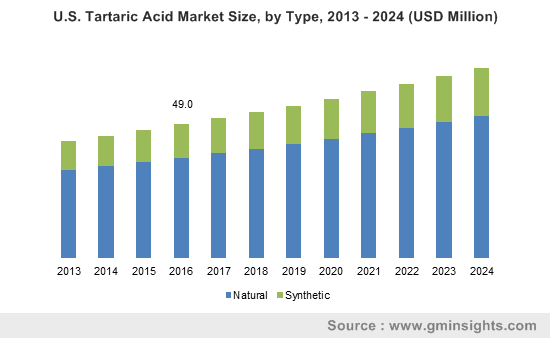Home > Chemicals & Materials > Specialty Chemicals > Custom Synthesis > Tartaric Acid Market
Tartaric Acid Market Analysis
- Report ID: GMI1673
- Published Date: Feb 2018
- Report Format: PDF
Tartaric Acid Market Analysis
Natural tartaric acid dominates the market, regarding both volume, and revenue. The demand for this product is predicted to grow at a CAGR over 3% in the projected period. Increasing product consumption in producing wine and some other beverages is anticipated to drive the tartaric acid market over the forecast period.
Synthetic tartaric acid is anticipated to surpass USD 150 million by the end of 2024. This product finds rising applications in manufacturing FMCG products such as cosmetics, personal care products, production of diacetyl tartaric acid esters of mono and diglycerides, and construction chemicals, thus the tartaric acid market demand is projected to grow with a lower rate compared to natural tartaric acid over the forecast period.
Global tartaric acid is segmented into wine, food & beverage, FMCG, pharmaceutical, and others. The product demand for wine production had the most significant market share in 2016 and is projected to grow at a CAGR of over 3% until the end of 2024.. Increasing demand for wine will significantly drive tartaric acid consumption. The product demand from FMCG products such as cosmetics and personal care products is anticipated to have the second-major market share over the entire forecast period.
Tartaric acid for food & beverage has the third-largest market share, regarding both volume, and revenue throughout the projected period. The product demand is also predicted to grow for food & beverages, as they are majorly consumed for flavor modification in beverages. Apart from beverages, and nutritional products, tartaric acid also finds applications in bakery products and various confectionary items.
Europe had a significant share in 2016 and will continue to dominate the global market till the end of forecast period. High wine production activities in European countries such as Italy, France, Spain, and Germany will drive the tartaric acid market value in the Europe over the forecast period.
Asia Pacific had the second-major share of the global market in 2016 and will grow at a CAGR over 4% until the end of 2024. High product demand from pharmaceutical, cosmetics, personal care products, and construction chemicals will significantly drive the tartaric acid market share over the forecast period.

